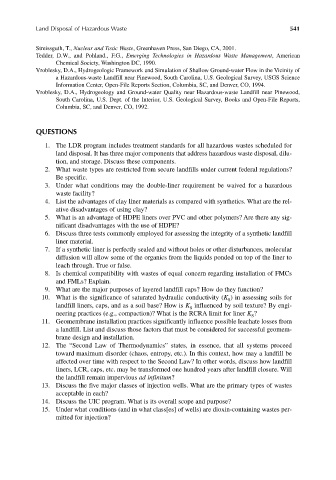Page 570 - Materials Chemistry, Second Edition
P. 570
CAT3525_C17.qxd 1/27/2005 12:44 PM Page 541
Land Disposal of Hazardous Waste 541
Streissguth, T., Nuclear and Toxic Waste, Greenhaven Press, San Diego, CA, 2001.
Tedder, D.W., and Pohland., F.G., Emerging Technologies in Hazardous Waste Management, American
Chemical Society, Washington DC, 1990.
Vroblesky, D.A., Hydrogeologic Framework and Simulation of Shallow Ground-water Flow in the Vicinity of
a Hazardous-waste Landfill near Pinewood, South Carolina, U.S. Geological Survey, USGS Science
Information Center, Open-File Reports Section, Columbia, SC, and Denver, CO, 1994.
Vroblesky, D.A., Hydrogeology and Ground-water Quality near Hazardous-waste Landfill near Pinewood,
South Carolina, U.S. Dept. of the Interior, U.S. Geological Survey, Books and Open-File Reports,
Columbia, SC, and Denver, CO, 1992.
QUESTIONS
1. The LDR program includes treatment standards for all hazardous wastes scheduled for
land disposal. It has three major components that address hazardous waste disposal, dilu-
tion, and storage. Discuss these components.
2. What waste types are restricted from secure landfills under current federal regulations?
Be specific.
3. Under what conditions may the double-liner requirement be waived for a hazardous
waste facility?
4. List the advantages of clay liner materials as compared with synthetics. What are the rel-
ative disadvantages of using clay?
5. What is an advantage of HDPE liners over PVC and other polymers? Are there any sig-
nificant disadvantages with the use of HDPE?
6. Discuss three tests commonly employed for assessing the integrity of a synthetic landfill
liner material.
7. If a synthetic liner is perfectly sealed and without holes or other disturbances, molecular
diffusion will allow some of the organics from the liquids ponded on top of the liner to
leach through. True or false.
8. Is chemical compatibility with wastes of equal concern regarding installation of FMCs
and FMLs? Explain.
9. What are the major purposes of layered landfill caps? How do they function?
10. What is the significance of saturated hydraulic conductivity (K ) in assessing soils for
S
landfill liners, caps, and as a soil base? How is K influenced by soil texture? By engi-
S
neering practices (e.g., compaction)? What is the RCRA limit for liner K ?
S
11. Geomembrane installation practices significantly influence possible leachate losses from
a landfill. List and discuss those factors that must be considered for successful geomem-
brane design and installation.
12. The “Second Law of Thermodynamics” states, in essence, that all systems proceed
toward maximum disorder (chaos, entropy, etc.). In this context, how may a landfill be
affected over time with respect to the Second Law? In other words, discuss how landfill
liners, LCR, caps, etc. may be transformed one hundred years after landfill closure. Will
the landfill remain impervious ad infinitum?
13. Discuss the five major classes of injection wells. What are the primary types of wastes
acceptable in each?
14. Discuss the UIC program. What is its overall scope and purpose?
15. Under what conditions (and in what class[es] of wells) are dioxin-containing wastes per-
mitted for injection?

